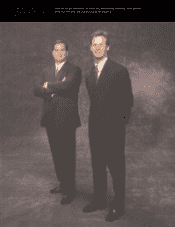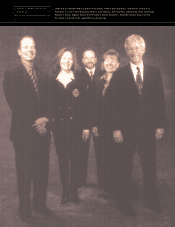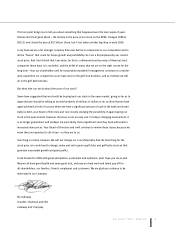Callaway 1999 Annual Report Download - page 19
Download and view the complete annual report
Please find page 19 of the 1999 Callaway annual report below. You can navigate through the pages in the report by either clicking on the pages listed below, or by using the keyword search tool below to find specific information within the annual report.
17CALLAWAY GOLF COMPANY
MANAGEMENT’SDISCUSSION AND ANALYSIS OF FINANCIAL CONDITION AND RESULTS OF OPERATIONS
RESULTS OF OPERATIONS
Years Ended December 31, 1999 and 1998
For the year ended December 31, 1999, net sales increased
$16.9million, or 2%, to $714.5million from $697.6million in
the prior year. The increase is attributable to an increase in
sales of metal woods, particularly titanium metal woods, par-
tially offset by a decrease in sales of irons and by sales of
non-current product through a managed close-out process at
substantially reduced prices. The increase in metal woods
sales of $39.1million (10%) is largely attributable to the
January 1999 introduction of Great Big Bertha®Hawk Eye®
Titanium Metal Woods and increases in sales of Big Bertha®
Steelhead™Metal Woods, which were introduced in August
1998. Sales of irons decreased $7.8million, primarily as a
result of a $27.6million decrease in sales of Big Bertha®
X-12®Irons, which were introduced in January 1998, partially
offset by sales from the August 1999 introduction of Hawk
Eye®Tungsten Injected™Titanium Irons of $27.7million.
Sales of Odyssey®and Callaway Golf®putters decreased $7.5
million (14%). Sales of other products decreased $6.9million
(30%). Also included in 1999 net sales were $56.6million in
sales of non-current product, most of which were sold at
close-out prices.
In terms of net sales by region, sales in the United States
decreased $23.5million (5%) to $414.1million for the year
ended December 31, 1999. Net sales in Japan decreased $5.5
million (9%) to $55.9million, as net purchases by the
Company’s distributor declined in anticipation of the transition
of distribution of Callaway Golf®products from it to the
Company’s wholly-owned Japanese subsidiary. Net sales to
Europe remained relatively constant at $115.7million and net
sales to the rest of Asia and the rest of the world increased
$38.9million (114%) and $7.6million (16%), respectively.
Sales to the rest of Asia increased in 1999 over 1998 due large-
ly to the economic recovery of the Korean market in 1999 and
the introduction of higher-margin products in Korea during
1999. The Company does not expect that revenue in Korea will
continue to increase at a rate comparable to 1999.
For the year ended December 31, 1999, gross profit
increased to $338.1million from $296.0million in the prior
year, and as a percentage of net sales increased to 47% from
42%. The increase is primarily due to lower obsolescence
charges in 1999 vs. a $30.0million excess inventory charge
recorded in the fourth quarter of 1998, and an increase in
sales of metal woods (which carry higher margins). However,
gross profit was unfavorably affected by price reductions on
the sales of non-current products through the Company’s man-
aged close-out program and an increase in distribution costs
associated with the Company’s foreign subsidiaries.
Selling expenses decreased to $131.9million in 1999
from $147.0million in the prior year. As a percentage of net
sales, selling expenses decreased to 18% from 21%. This
decrease is primarily attributable to planned reductions in
advertising, pro tour and other promotional expenses, partial-
ly offset by an increase in employee compensation.
General and administrative expenses decreased to $92.5
million in 1999 from $98.0million in 1998, or 13% and 14% of
net sales, respectively. This decrease is largely due to decreas-
es in consulting, bad debt expense and supplies expense, as
well as a decrease in building-related costs associated with
the Company’s 1998 restructuring program. These amounts
were partially offset by increases in costs associated with the
ramp-up of the Company’s golf ball operations and increased
depreciation and amortization expense related to the
Company’s foreign operations.
Research and development expenses decreased to $34.0
million (5% of net sales) in 1999 from $36.8million (5% of net
sales) in 1998. This decrease was primarily the result of the
shut-down of the Company’s prototype foundry and a decrease
in consulting fees, partially offset by increases in employee
compensation and component prototype costs.
Restructuring income primarily relates to the reversal of a
restructuring reserve recorded in 1998 for a lease obligation in
New York City that was subsequently assigned to a third party.
See Note 12 to the Consolidated Financial Statements for a
discussion of this and other restructuring transactions.
Sumitomo Rubber Industries, Ltd. (“Sumitomo”) transi-
tion costs represent payments for non-current product which
were associated with the transition of the distribution of
Callaway Golf®products from Sumitomo to a wholly-owned
subsidiary of the Company. See “Certain Factors Affecting
Callaway Golf Company – International Distribution” below
and Note 15 to the Consolidated Financial Statements for a
discussion of this transaction.
Interest and other income increased to $9.2million from
$3.9million for the year ended December 31, 1999 as com-
pared with the prior year. This increase is primarily attribut-
able to an increase in interest income resulting from higher
average cash and deferred compensation investment balances
during 1999 as compared with 1998, an increase in royalty
income and an increase in other income due to the receipt of
insurance proceeds related to the Company’s deferred com-
pensation plan.
Interest expense increased to $3.6million in 1999
from $2.7million in 1998. This increase is largely related to
























